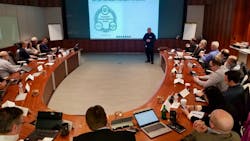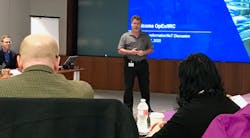CPG Manufacturers and OEMs Collaborate on Digital Transformation
Across industry, companies realize that digitizing and connecting their operations isn’t really a choice. It’s the direction all industry is moving toward. Keeping up with this movement is, ultimately, about keeping your business viable.
The reasons why many industrial companies remain hesitant about making the digital transformation are numerous. From cybersecurity, cost concerns, intellectual property protection, and workforce readiness to simply not knowing the best way to start, there’s no shortage of reasons why companies are not exactly rushing headlong into the fourth industrial revolution.
The goal of this meeting was to generate a starting point for the development of an Industrial Internet of Things (IIoT) landscape project. This project is designed to provide both CPG manufacturers and OEMs with an IIoT roadmap to help them navigate the digital transformation with best practices based on real-world application experience and expert technology insights.
Not industry’s first digital rodeo
Peter Zornio, Emerson’s chief technology officer, began the meeting by stressing that most industrial companies are still “figuring all this out” and that companies not at the forefront of this change are not necessarily losing ground, as many industry consultants imply.
“This is not the first time industry has undergone a digital transformation,” Zornio said. “Plants are full of digital, automated technologies. What’s happening now is that all these other processes—such as bringing safety to the point of zero injuries or accidents, optimizing production to market conditions, driving reliability to the point that there are no unplanned downtimes, reducing emissions and increasing energy efficiencies, automating routine tasks to empower the workforce to create more value, embedding collaboration in the work process culture, and supporting business decisions with analytics—have not previously been automated. The big opportunity for today’s digital transformation is closing the loop between all these yet-to-be-automated areas.”
CPG and OEM perspectives
After a series of presentations by Emerson technology experts exploring everything from artificial intelligence-enabled analytics and augmented reality-aided maintenance to edge computing and cybersecurity technologies, the CPG and OEM participants gathered to discuss their viewpoints and concerns.
The OEMs identified five priorities around IIoT based on the needs of their equipment and common end user concerns:
- Focus on “monitoring only” in remote access discussions with end users to alleviate concerns around remote control capabilities. Monitoring parameters should be established at the RFQ stage.
- Start small by concentrating on the beginning of line and/or primary package. The goal with this approach is two-fold: 1) focus on CPG packaging pain points and 2) not overwhelm the user with the technological possibilities.
- Convey an understanding of market segment differences that will impact technology needs and wants; for example, the regulatory and compliance issues affecting the pharmaceutical industry vs. those affecting food and beverage producers.
- Develop standards for interpreting monitored data that are consistent across OEMs.
- Create business models for OEMs that could accelerate CPG buy-in to the digital transformation idea; for example, an OEM-provided service that includes equipment, monitoring, and production optimization advice.
Related to this last point, the CPGs in attendance tend to view OEMs having remote access into their machines once they’re installed as being more of a benefit to the OEMs than the CPGs. In short, OEMs will have their work cut out for them in their pursuit of a services business model that includes remote monitoring.
From the CPG side, the following five points were highlighted as major areas of concern around connecting equipment for IIoT applications:
- Reliability and yield are CPG manufacturers’ two biggest cost factors; “OEMs need to move the needle in these areas with any solution they recommend,” said one CPG representative.
- OEMs should address the form, fit, and function of their equipment from an open architecture perspective. The CPG manufacturers stressed that they need to be able to add to the machines once installed as necessary to achieve their production- and business-related goals.
- Data collection and transmission should be standardized and open so that data can be accessed and used in a scalable manner. CPG manufacturers want to be able to look forward and back through their machine data to review their progress and ensure they are staying on track to achieve specific goals.
- CPG manufacturers want OEMs to help them understand what data from their equipment is most valuable and where it falls in a hierarchy of machine-generated data. A CPG representative in the meeting said, “We need OEMs to teach us how to get the maximum value from their machines.”
- Discontinue the use of embedded operating systems in packaging machinery. Several CPG manufacturers noted issues they’re having with embedded software that is no longer supported and can’t be easily updated or replaced.
Next steps
For PMMI’s OpX Leadership Network, the next steps in developing the IIoT roadmap will involve outlining ways to create and maintain a three-way conversation around the digital transformation that includes the CPG, OEM, and automation technology supplier to:
- Explain the use of edge computing devices as a starting point for IIoT enablement;
- Target and resolve downtime on specific pieces of packaging machinery equipment;
- Identify troublesome equipment and how to improve it in a holistic manner that addresses production as a whole;
- Make packaging machine technology open and vendor agnostic; and
- Develop a path for machine obsolescence in light of ongoing IIoT technology advances that are beneficial to OEMs and CPG manufacturers.
About the Author
David Greenfield, editor in chief
Editor in Chief

Leaders relevant to this article:


